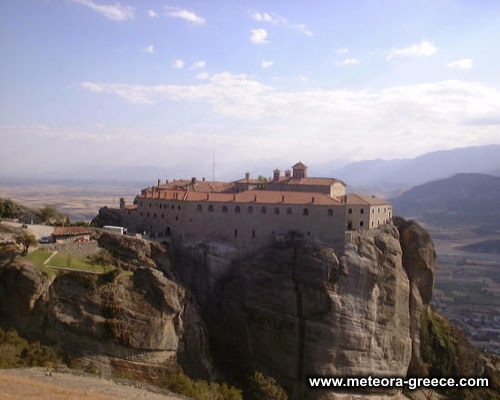The Holy Monastery of Saint Stephen at first was male, but since 1961 there has been a sisterhood. Owners are Holy Antony, in the early and mid 15th century and Holy Philotheos, who, in the middle of the 16th century, rebuilt the church of Saint Stephen.In the 16th century, the first frescos of the church are also created.

After 1798, under Bishop of Stagi Paisios from Klinobo of Kalampaka and of the abbot Amvrosios, the present catholic was built in the honour of Saint Charalambos, whose blessed skull is kept there as the most sacred and miraculous heirloom. The frescos at the catholic are created by Vlasis Tsotsonis, perhaps the most important modern hagiographer.
At the Holy Convent of Saint Stephen, in the old “trapeza”(dining hall) that has turned into a museum, there is a remarkable and rich collection of manuscripts, icons and sacred heirlooms.
The history of the first years of the monastery is lost in the depths of centuries and is full of traditions. According to early evidence, its foundation is dated to the end of the 12th century, approximately in 1191 or in 1192. Probably the name of the first holy hermit who settled on a cave of the rock was Jeremy. However, there is ascertained evidence since the 14th century. According to this evidence, the St. Stephen Monastery was an organized coenobium. So, the following persons are mentioned as founders of the monastery: firstly, archimandrite Saint Anthony (in the first half of the 15th century), whose father was a Serb sovereign and his mother was offspring of the Byzantine Kantakouzenos family; secondly, the priest-monk Saint Philotheus from Rizoma of Trikala (in the mid-16th century).
Saint Philotheus rebuilt the old small katholikon of the monastery (the church of St. Stephen) approximately in 1545. He also built cells for the monks and other useful buildings. During its history, the monastery enjoyed noble protection and help of noblemen from Byzantium, Principalities bordering on the Danube and Ecumenical Patriarchate of Constantinople. In 1798, when Amvrosios was abbot of the monastery, the present imposing katholikon honoured to St. Charalambus was built. However, unfavourable events during the first half of the 20th century almost led to the dissolution of the monastery. Since 1961, it became convent and so, a new glorious period began.
According to an old tradition, this monastery is connected with female monasticism. Later, it was desolated and abandoned, until it was inhabited again by monks. The abbot of the monastery, Constantios from Kakambaka, was very active (in spiritual, social matters, matters of building etc.) in the mid-19th century. During these hard times, his contribution to education was particularly important. About 100 years ago, more than 30 monks lived in the monastery, but in 1960 it was almost desolated. In 1961, the monastery became a convent. The first nuns who settled here managed, with the help of God, to organize the monastery in a coenobitic way and to ameliorate its buildings despite the particularly difficult conditions. The present community consists of 28 nuns and its abbess is Agathi Antoniou.
